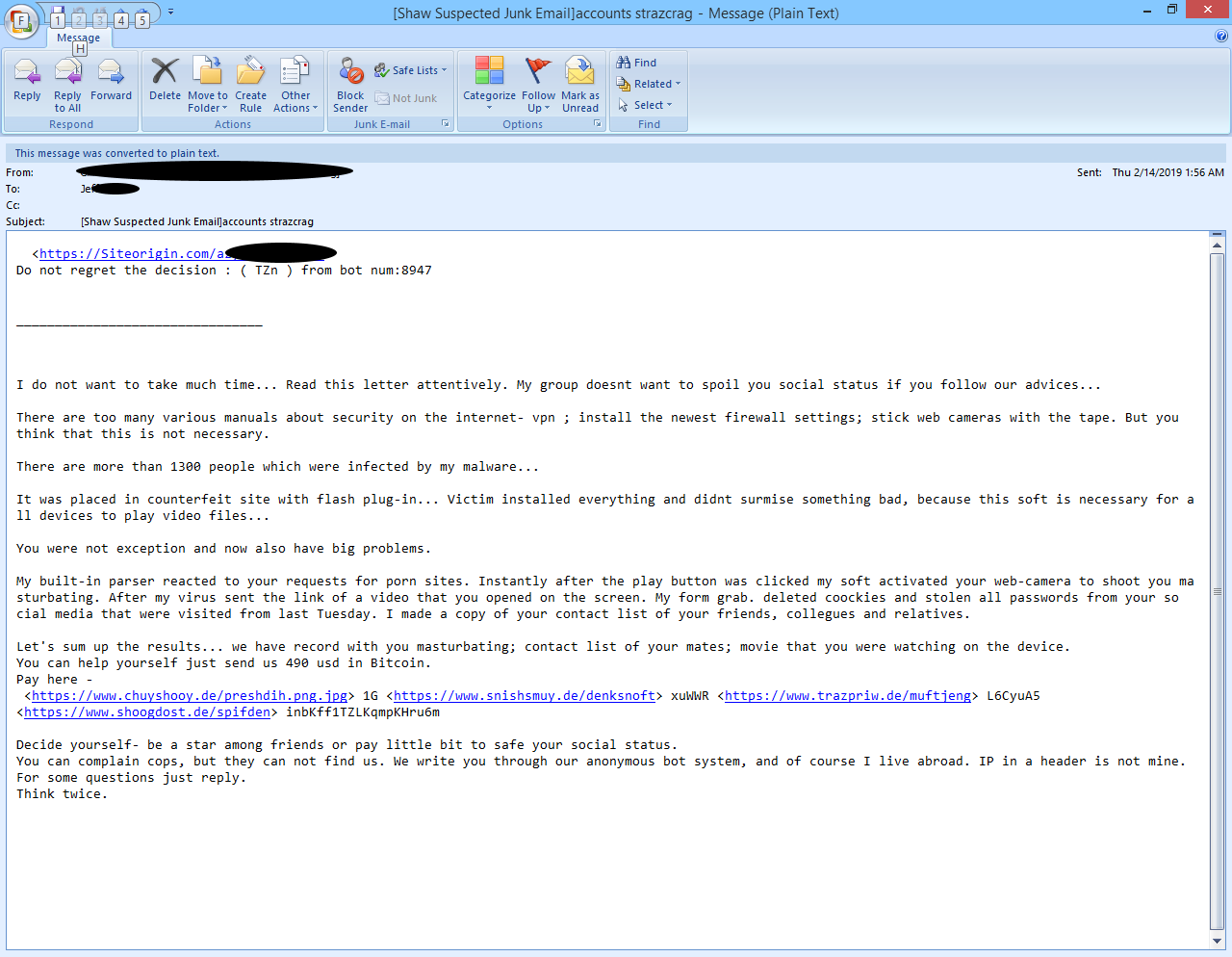 If you have an email address, and you’ve ever used it to register for online services and sites, there’s a good chance you’ve received email that threatens you in some way, and some of it is downright creepy.
If you have an email address, and you’ve ever used it to register for online services and sites, there’s a good chance you’ve received email that threatens you in some way, and some of it is downright creepy.
This email may refer to your name. It may include a password you’ve used in the past, or even currently. The email may appear to have been sent from your own email address, and may claim to have taken over that email account.

The good news is that very little of what these emails claim is actually true. The bad news is that you still have a problem.
But why does this happen?
It all starts when someone gets careless, or someone else decides that the IT budget is too high.
Imagine that you’re the person responsible for information security at any company that… uses computers (so basically, any company on the planet). Now imagine that you’re bad at your job. Or disgruntled. Or your manager keeps cutting your budget. Inevitably, things start to slide. Security updates don’t get installed. Software that isn’t properly checked for security implications gets installed on company computers. Users don’t get security training. Bad decisions are made, such as not properly encrypting user passwords. And so, the company’s computers, and the data they contain, become vulnerable. Eventually, malicious people figure this out, and through various means — many of which are trivially simple to carry out — gain access to your data. And that data includes information about your customers. That information is then sold online, to other, even less scrupulous people. Brian Krebs documents many of these breaches; here’s one example.
You can find these lists online if you know where to look. Some are only accessible from the dark web. Some are published more brazenly, on easily-accessed public web sites, including Facebook.
Sometimes these lists contain passwords. In really awful cases, the passwords aren’t even encrypted. But usually they are encrypted, which makes them slightly less useful. Only slightly, because many people still use terrible passwords: common passwords, like 1234; passwords that are used by the same person in multiple places; and passwords that are easy to crack.
Any password can be cracked, by which I mean converted from its encrypted form to its original, unencrypted form. Short and simple passwords can be cracked in nanoseconds. Longer, more complex passwords take longer. At any given point in time, passwords that are long and complex enough simply can’t be cracked quickly enough to be worth the attempt. This is a moving target. As computers get faster, the point at which a password becomes worth cracking gets nearer.
You can find out just how terrible your password is using howsecureismypassword.net. Note: the site is safe to use: it uses a small Javascript program that runs only on your computer. Your password is never transmitted anywhere. And it’s not actually being cracked; the Javascript code just assesses the complexity of your password based on various formulae. It’s an estimate, but reasonably accurate. Go ahead, I’ll wait.
Useful lists
These shady lists of users, passwords, and email addresses can be used for lots of things, ranging from merely irritating to criminal. But there’s money to be made, as long as you don’t care about being a world-class asshole.
If you’re an asshole, and you’re looking for an easy way to make money and irritate people, just shell out a few bucks for one of these lists, and download a few scripts that turn that list into spam. Because computers are really good at things like this, you hardly have to do any actual work. Just feed a list into some crappy script, sit back, and watch the money pour in. If you had to do this with paper and snail mail, it clearly would not be worthwile.
A user’s story
Let’s look at this another way: from the perspective of Iam Notreal, an ordinary Internet user. Iam registered for an account at LinkedIn in 2011 using his real name and his NopeMail account, iam.notreal@nopemail.com. He also used the same password he uses everywhere else: banana1234.
In 2012, intruders gained access to LinkedIn servers and were able to download its user database. The database included usernames, email addresses, and poorly-encrypted passwords. Now Iam’s real name, real email address, and an encrypted form of his one and only password are on a list, and, beginning in 2016, that list is being sold on the dark web to anyone who has a few bucks to spare.
In 2016, Iam starts getting spam to his NopeMail account. Most of it is ordinary spam: poorly-worded appeals to click a link. Occasionally he receives spam that mentions his real name, which is alarming, but not particularly harmful. At some point, Bill tries to ‘unsubscribe’ from what he believes is a mailing list, by replying to one of these spam emails. Congratulations, Iam, you’ve just graduated to a new list, of confirmed, valid, active email addresses. This list will also be sold on the dark web, at a higher price than the original list.
Meanwhile, other dark forces are at work behind the scenes. Someone runs the original list through a widely-available password cracker. This software looks at each encrypted password and attempts to decrypt it based on a set of parameters, including lists of commonly-used passwords. Sadly, Iam’s password is rather short, and contains a common word, and it takes the software about a nanosecond to crack it. Now Iam is on an even more valuable list, which includes cracked passwords.
Fast forward to 2018, and now Iam is getting email that claims to have taken over his email account, or to have video from Iam’s own webcam showing him doing unmentionable things, and it also includes Iam’s one and only password, right there in plain text. Iam is panicked: if the sender knows his password, are the rest of the claims true? He doesn’t know it, but the sender’s claims are bullshit.
As scary as this sounds, it’s only the most common use of lists like these circa late 2018, early 2019. The same information could be used to take over Iam’s LinkedIn account (if he ignored warnings from LinkedIn to change his password, or if he changed it back to the same password), take over his NopeMail account (if he failed to change its password after the LinkedIn breach), or take over any other account that can be found on any other service he uses, once it’s discovered.
Questions
Why is that spam coming from my own email address or my own mail server?
Unfortunately, it remains trvially easy to spoof almost all information contained in an email message. Current anti-spam efforts like SPF, DKIM, and DMARC are focused on validation, and there’s nothing stopping anyone from spewing out email with mostly-forged headers. That includes the FROM header, which means scammers can make email look like it came from just about any address they want. Only close inspection of all the headers reveals the actual source.
Why does that spam contain my password?
If a scammer has access to a purloined user list that includes plaintext or cracked passwords, it’s a simple matter of customizing the content of their malicious spam so that the username and/or password vary, depending on the unlucky recipient.
What you should do
Stop using crappy passwords. If you’re not sure how crappy your password is, check it at howsecureismypassword.net. You can also install this extension in your Chrome browser; it will warn you if your password is too weak.
Stop re-using passwords. If site A is hacked, and your password for site A is the same as for site B, you’ll have to change your password on both sites.
Use a password manager. Yes, it’s annoying to have an extra step whenever you want to log in somewhere, but using a password manager means that you only ever have to remember one password. They can also generate passwords for you, saving you the trouble.
Check Have I been pwned to see how many breaches have included your email addresses and passwords.
Sign up at Spycloud to continuously monitor your email address for inclusion in breaches.
Making noise
Although there are ways to use purloined user lists besides spam, most of the damage we see is related to email.
Despite being really old technology, email has continually improved in terms of security. Newer technologies like SPF, DKIM, and DMARC make it much easier for email providers to determine which email is legitimate and which is not.
You can help by making sure any email domains you manage use SPF, DKIM, and DMARC. If your mail provider doesn’t use these technologies, lean on them to start. If they resist, find another provider. I have several clients who use the business mail service provided by telecom giant Telus here in Canada. Telus farms this work out to a provider in the USA called Megamailservers. The Megamailservers service does not currently support DKIM or DMARC, and there’s nothing on their web site (or that of Telus) about any plans to change that.
Password Management Software
So, everyone should use a password manager. But wait, didn’t I just read that all the most popular password managers can be bypassed very easily? Yup. Opinions vary as to whether the risk of such exploits is significant. From my perspective, the risk is this: yes, a malicious actor needs physical, remote, or programmatic access to your computer to use these exploits. But once they have access, they no longer have to waste time looking for interesting information. All they need to do is look for password manager data and sent it to themselves. That makes their job MUCH easier.
But using a password manager is still much safer than not using one.
 boot13
boot13